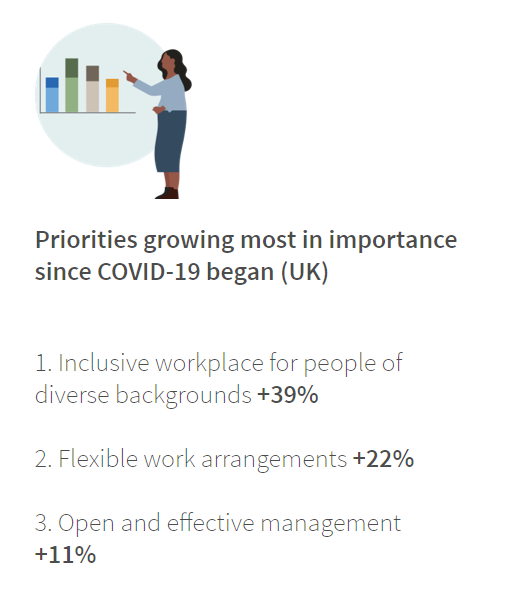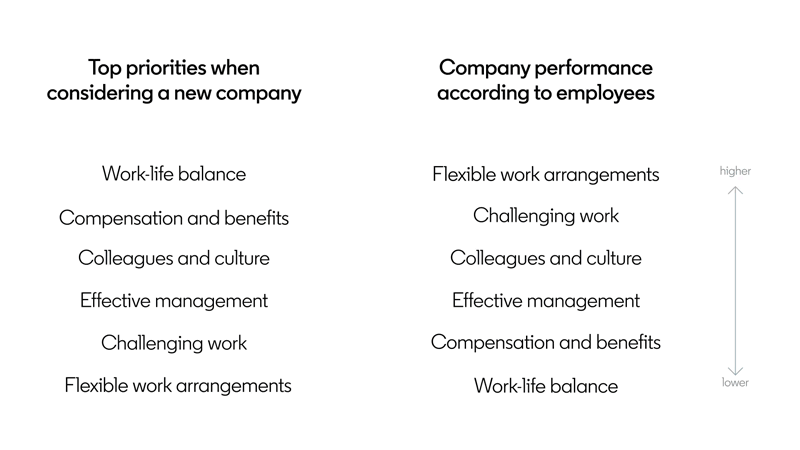LinkedIn data on what the talent market wants, employers need, and what we learn in the Great Reshuffle.
The global talent market has never changed this much, this quickly.
Call it the Great Reshuffle: a time when everyone is rethinking everything.
Employees reconsider where they work and why employers are recalibrating their talent needs and company culture. It’s a learning process for all involved. Furthermore, this report will help you understand the biggest changes since COVID-19 began.
How To Attract Candidates To Your Vacancy
Candidates are rethinking how they choose an employer.
Today’s top priorities when considering a new company (UK, June 2021):


In the UK, the biggest change in candidate priorities is inclusion and diversity in the workplace; the happiness this creates translates into success. Flexible work arrangements are a key focus, as over half of UK workers want to work from home in the future.
The last 18 months have also highlighted the importance of open and effective management, as this enables the balance to be happy and productive.
Global data shows companies are falling short of where it matters the most.

This may be because companies aren’t delivering what employees want. According to global data from Glint, work-life balance and compensation scored low on employee surveys over the past year.
Also, while flexibility is important, it doesn’t always mean better work-life balance. Global data from LinkedIn and Glint showed employees at remote-friendly companies were 32% more likely to struggle with work-life balance.
What employers need from talent
Employer demand for certain roles is rising fast.
Jobs with the fastest-growing demand
Q2 2021 vs. Q2 2020 (UK)
1. Delivery Driver +37x
2. Customer Assistant +17x
3. Javascript Developer +12x
4. Sales Executive +6x
5. Cloud Engineer +6x
IT career prospects remain strong.
Furthermore, the rising demand for cloud engineers has highlighted several roles that have always been in high demand and, over the last 18 months, have remained somewhat ‘pandemic-proof’. Moreover, while there has been a surge in roles within sectors that grew during COVID-19, there is still strong demand for highly-skilled tech and IT professionals.
People are learning skills to meet talent market demands.
Most popular courses on LinkedIn Learning

1. Unconscious Bias
2. Strategic Thinking
3. Excel Essential Training
4. Speaking Confidently and Effectively
5. Diversity, Inclusion, and Belonging
6. Communicating with Confidence
7. Learning Excel 2019
8. Delivering an Authentic Elevator Pitch
9. Agile Foundations
10. SQL Essential Training
Creating an inclusive, equitable workplace for all

The single most popular course over the last year was Unconscious Bias, taught by Stacey Gordon. It was one of many popular courses that aim to promote a workplace culture of diversity and inclusion.
We’ve already seen how an inclusive workplace is increasingly important to candidates. Over 44,000 learners have watched this course signalling that people are investing time and acting to foster belonging at their organisations.
Tech Skills
Furthermore, hard data skills also cropped up often in the most popular courses, from mastering Microsoft Excel to learning SQL to deal with databases. Since the pandemic only accelerated digital transformation trends, businesses need the talent to translate the ever-growing stores of raw data into actionable insights.

Looking forward to a post-pandemic future
With the great reshuffle among us, and likely to continue for the foreseeable future, these figures show that the more human side of the workforce the pandemic has brought out is something that candidates will look for to ensure their happiness in the workplace. However, not just passively, but so many actively seek training to ensure more diverse and inclusive workplaces.
And whether that’s in the office, at home, or a hybrid of the two, this is a trend that looks to carry on in the post-pandemic future, as a happier and more balanced workforce has proven to be a more productive one. Therefore, it’s in everyone’s best interests to make the most of this change by communicating the core values that line up with this and taking steps to ensure a supportive and more diverse workplace.

Get articles like
this via email
- Join 2,800 others
- Never miss an insight

